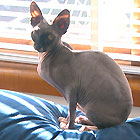Sphynx cat Temperament:
playful, inquisitive Cost:
$2000 Lifespan:
15 years Maintenance:
medium Recommended for:
funky feline lovers
BREED:
Sphynx cat
COSTS:
$2000 desexed, vaccinated and micro-chipped. Feeding $10/wk.
GROOMING:
Recommend weekly bathing.
CHILD COMPATIBILITY:
Very friendly with kids.
TEMPERAMENT:
Playful and inquisitive.
ACTIVITY LEVEL:
Can be hyperactive and mischievous at times.
AVAILABILITY:
Only two breeders. Waiting lists apply.
TRAINABILITY:
Can be taught to walk on lead and harness.
SATISFACTION RATING:
No reported incidence of surrenders to pounds.
AGGRESSION:
Not known to be aggressive. Males are placid.
HEALTH & LIFESPAN:
10-15 years. Protect from extremes of heat and cold.
NOISE:
Not excessively vocal.
INDOORS POTENTIAL
Ideal for indoors.
IDEAL FOR:
Young, professional couples.
POPULARITY:
A rare breed.
TURN-ONS:
Personality and unique appearance.
TURN-OFFS:
Higher food bills. Can leave dirty marks.
INTERESTING FACTS:
Sphynx is spelt with a “Y” rather than an “I”.
The True Sphinx
The true Sphinx is a stone monument carved from the bedrock of the Giza plateau, Egypt. It has the body of a lion with the head of what is likely to be a king or god.
There are many theories about the origins of the Sphinx. The most popular; that it was commissioned by the 4th Dynasty King, around 2558-2532 B.C. It is estimated to be around 4,500 year old.
Sphynx is spelt with a “Y” rather than an “I”. Why this is, is unknown.
The Breed
The gene of hairlessness in dogs and cats has appeared as a spontaneous mutation several times during the past century.
The first breeding program for hairless cats was initiated in Canada in 1966, when a domestic shorthaired cat produced a hairless kitten. These early cats were at first called “The Canadian Hairless”, “Moonstone Cats” and “Canadian Sphynx”. Over time “Sphynx” became the official name. The lineage of these Canadian hairless cats only continued for a brief time and other hairless kittens that appeared spontaneously in various litters in the United States during the 1970s became the true corner stone of the breed. The Sphynx is not recognised by all associations.
Appearance
The Sphynx isn’t actually a hairless cat. On closer look, one will see that it is actually covered with a very fine down. The skin feels quite a bit like a chamois. Hair is most likely to appear around the ears, muzzle, tail, feet and scrotum. The lack of coat makes the cat feel quite warm to the touch.
A lion tail – a puff of hair on the tip of the tail, is apparent in some cats. The tail is whippy, and tapers from the body to the tip, akin to a rat’s tail. The kitten’s skin is very wrinkled and as the cat ages, the wrinkles will diminish, although not completely.
The Sphynx is very muscular. It isn’t a delicate cat. All colours and patterns may occur including any amount of white.
Temperament
The Sphynx is sweet-tempered, lively, intelligent and amenable to handling. It can be demanding of its owner’s time, always wanting to be close and touched, however it isn’t a vocal breed. Breeders regard the Sphynx as a communal cat and say that males will get on with each other.
Health
The main problem is the breed’s potential to suffer from the extremes of heat and cold. A small dog jumper or the cut sleeve of a pullover is handy to have around in periods of cold. Pale-skinned cats are most susceptible to sunburn, although all can burn if not provided with adequate protection. Skin cancer from exposure to the sun is not only limited to humans. Ensure that the cat has access to shade during the hot months.
The ears lack hairs to filter dust and dirt and need to be cleaned out weekly. Breeders say that a Sphynx will eat a lot more food than another breed of equal size and this is likely to be a means of regulating body temperature in the colder months. Some individuals will be more sensitive to the cold than others and if their immunity becomes depressed, respiratory illnesses can set in. These can be difficult to treat too. Breeders say that some lines are known to have weak immunities.
Grooming
While no brushes are needed, a weekly bath will keep the skin clear of oils and dust that may ultimately end up on your furniture if the cat isn’t kept clean. Breeders say that the cat can leave a ‘shadow’ on your white sheets if the cat isn’t cleaned often enough. Baby wipes are often used between bathings.
Ideal owner
The breed’s appearance is a turn-off to many, whilst it is the main factor for most other people who select this cat. Breeders say that it is popular with young trendy professionals, because of its funky look and also the lack of hair that is left around the house. Despite the lack of shedding hair, time is still required to bath the cat and address any needs that may arise from extremes of temperature. There are only two breeders in Australia, Sydney and Perth. Waiting lists apply up to 18 months.
Those who are allergic to cats should not be fooled into thinking this breed is best for them. It is possible that you may be allergic to this breed as allergies are often caused by the cat’s saliva rather than the hair.
Housepet potential
A breed that’s not scared of strangers and likes attention. When visitors come, expect your Sphynx to be first to greet them at the door.
Further information
We filmed this segment with Sphynx breeder, Mr. Aaron Hellier. Aaron lives on the NSW South Coast and can be contacted on 0419 698 811.
Angela Irvine, lives in Gosnells, Western Australia. Angela was responsible for importing the breed into Australia.
Phone 0416 195 211
Email: [email protected]
Web: www.ragtail.com.au



